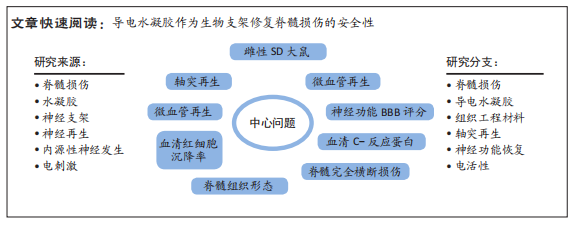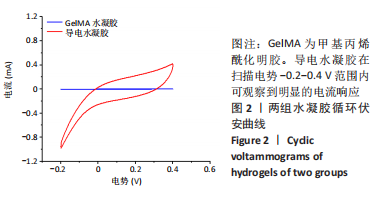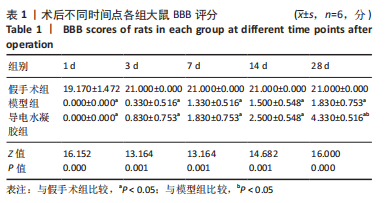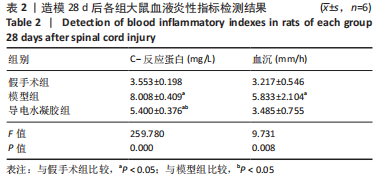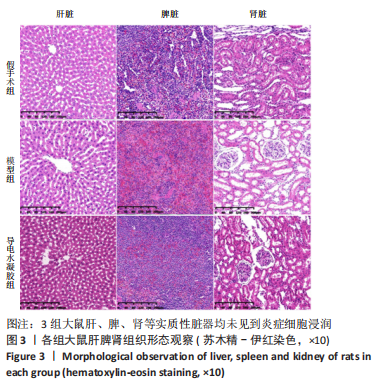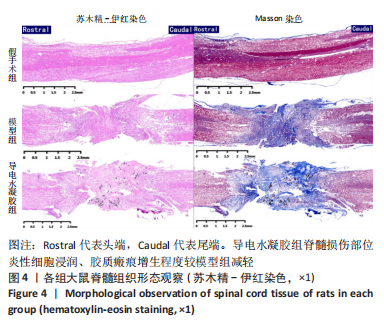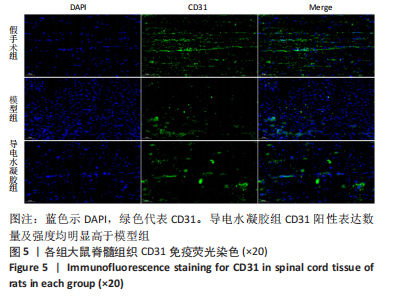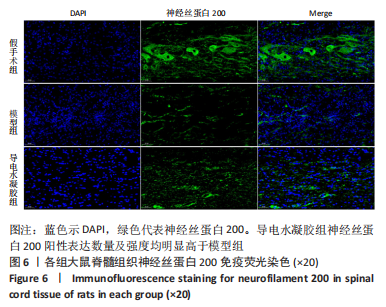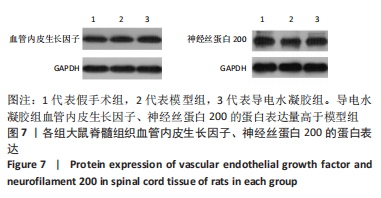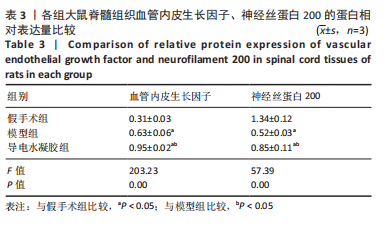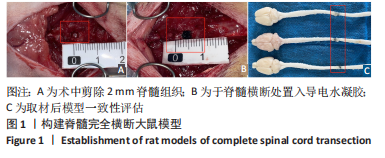[1] KOFFLER J, ZHU W, QU X, et al. Biomimetic 3D-printed scaffolds for spinal cord injury repair. Nat Med. 2019;25(2):263-269.
[2] KARSY M, HAWRYLUK G. Modern Medical Management of Spinal Cord Injury. Curr Neurol Neurosci Rep. 2019;19(9):65.
[3] DUMONT CM, CARLSON MA, MUNSELL MK, et al. Aligned hydrogel tubes guide regeneration following spinal cord injury. Acta Biomater. 2019;86:312-322.
[4] ANDERSON MA, O’SHEA TM, BURDA JE, et al. Required growth facilitators propel axon regeneration across complete spinal cord injury. Nature. 2018;561(7723):396-400.
[5] 王健豪,刘洋,付玄昊,等.3D打印组织工程支架联合骨髓间充质干细胞移植修复脊髓损伤[J].中华骨科杂志,2021,41(6):376-385.
[6] DOMINICI N, KELLER U, VALLERY H, et al. Versatile robotic interface to evaluate, enable and train locomotion and balance after neuromotor disorders. Nat Med. 2012;18(7):1142-1147.
[7] BERTUCCI C, KOPPES R, DUMONT C, et al. Neural responses to electrical stimulation in 2D and 3D in vitro environments. Brain Res Bull. 2019;152:265-284.
[8] TABATABAEI F, MOHARAMZADEH K, TAYEBI L. Fibroblast encapsulation in gelatin methacryloyl (GelMA) versus collagen hydrogel as substrates for oral mucosa tissue engineering. J Oral Biol Craniofac Res. 2020; 10(4):573-577.
[9] GONG H, FEI H, XU Q, et al. 3D-engineered GelMA conduit filled with ECM promotes regeneration of peripheral nerve. J Biomed Mater Res A. 2020;108(3):805-813.
[10] CHENG J, CHEN Z, LIU C, et al. Bone mesenchymal stem cell-derived exosome-loaded injectable hydrogel for minimally invasive treatment of spinal cord injury. Nanomedicine (Lond). 2021;16(18):1567-1579.
[11] BASSO DM, BEATTIE MS, BRESNAHAN JC. A sensitive and reliable locomotor rating scale for open field testing in rats. J Neurotrauma. 1995;12(1):1-21.
[12] SAREMI J, MAHMOODI N, RASOULI M, et al. Advanced approaches to regenerate spinal cord injury: The development of cell and tissue engineering therapy and combinational treatments. Biomed Pharmacother. 2021;146:112529.
[13] LUKACOVA N, KISUCKA A, KISS BIMBOVA K, et al. Glial-Neuronal Interactions in Pathogenesis and Treatment of Spinal Cord Injury. Int J Mol Sci. 2021;22(24):13577.
[14] DUAN YY, CHAI Y, ZHANG NL, et al. Microtubule Stabilization Promotes Microcirculation Reconstruction After Spinal Cord Injury. J Mol Neurosci. 2021;71(3):583-595.
[15] OYINBO CA. Secondary injury mechanisms in traumatic spinal cord injury: a nugget of this multiply cascade. Acta Neurobiol Exp (Wars). 2011;71(2):281-299.
[16] WANG Y, LV HQ, CHAO X, et al. Multimodal therapy strategies based on hydrogels for the repair of spinal cord injury. Mil Med Res. 2022; 9(1):16.
[17] LI Y, YANG L, HU F, et al. Novel Thermosensitive Hydrogel Promotes Spinal Cord Repair by Regulating Mitochondrial Function. ACS Appl Mater Interfaces. 2022;14(22):25155-25172.
[18] PERALE G, ROSSI F, SUNDSTROM E, et al. Hydrogels in spinal cord injury repair strategies. ACS Chem Neurosci. 2011;2(7):336-345.
[19] FAN L, LIU C, CHEN X, et al. Directing Induced Pluripotent Stem Cell Derived Neural Stem Cell Fate with a Three-Dimensional Biomimetic Hydrogel for Spinal Cord Injury Repair. ACS Appl Mater Interfaces. 2018;10(21):17742-17755.
[20] COURTINE G, GERASIMENKO Y, VAN DEN BRAND R, et al. Transformation of nonfunctional spinal circuits into functional states after the loss of brain input. Nat Neurosci. 2009;12(10):1333-1342.
[21] GEREMIA NM, GORDON T, BRUSHART TM, et al. Electrical stimulation promotes sensory neuron regeneration and growth-associated gene expression. Exp Neurol. 2007;205(2):347-359.
[22] ZHOU L, FAN L, YI X, et al. Soft Conducting Polymer Hydrogels Cross-Linked and Doped by Tannic Acid for Spinal Cord Injury Repair. ACS Nano. 2018;12(11):10957-10967.
[23] LUO Y, FAN L, LIU C, et al. An injectable, self-healing, electroconductive extracellular matrix-based hydrogel for enhancing tissue repair after traumatic spinal cord injury. Bioact Mater. 2021;7:98-111.
[24] 刘翔宇,王照东,徐陈,等.载外源性TGF-β_1甲基丙烯酰化明胶复合支架促进颅骨缺损修复实验研究[J].中国修复重建外科杂志, 2021,35(7):904-912.
[25] 穆琳,曾今实,黄元亮,等.3D生物打印脂肪来源干细胞联合甲基丙烯酰化明胶构建组织工程软骨的实验研究[J].中国修复重建外科杂志,2021,35(7):896-903.
[26] HASSANZADEH P, ATYABI F, DINARVAND R. Tissue engineering: Still facing a long way ahead. J Control Release. 2018;279:181-197.
[27] 贺丰,俞兴,穆晓红,等.新型脊髓完全横断缺损模型大鼠的建立[J].中国组织工程研究,2016,20(5):635-639.
[28] ALIZADEH A, DYCK SM, KARIMI-ABDOLREZAEE S. Traumatic Spinal Cord Injury: An Overview of Pathophysiology, Models and Acute Injury Mechanisms. Front Neurol. 2019;10:282.
[29] ANWAR MA, AL SHEHABI TS, EID AH. Inflammogenesis of Secondary Spinal Cord Injury. Front Cell Neurosci. 2016;10:98.
[30] JOSHI HP, KUMAR H, CHOI UY, et al. CORM-2-Solid Lipid Nanoparticles Maintain Integrity of Blood-Spinal Cord Barrier After Spinal Cord Injury in Rats. Mol Neurobiol. 2020;57(6):2671-2689.
[31] LI H, KONG R, WAN B, et al. Initiation of PI3K/AKT pathway by IGF-1 decreases spinal cord injury-induced endothelial apoptosis and microvascular damage. Life Sci. 2020;263:118572.
|
